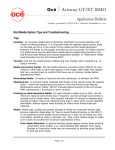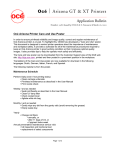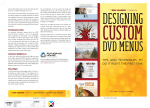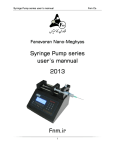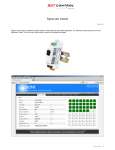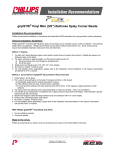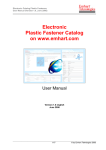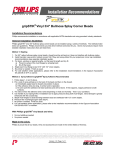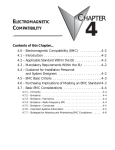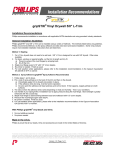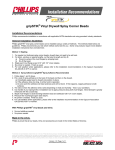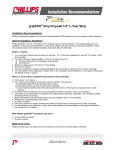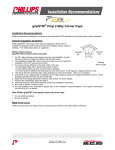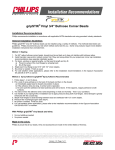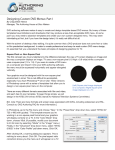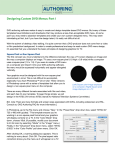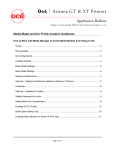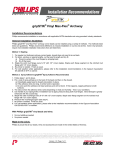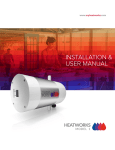Download How to Hold Media Flat on the Printer Table
Transcript
Océ ⏐ Arizona 250 GT Application Bulletin Number: 8 • Issued by: ODGS S & S, Vancouver • June 11, 2007 How to Hold Media Flat on the Printer Table The table on the Océ Arizona® 250GT flatbed printer uses a low flow, high-vacuum system to hold media in place. The vacuum panel overlay on the table surface is shipped with one large zone active, although it is possible to configure it into several custom zones to suit the operator’s preference. This re-configuration is done using the application of foam gasketing material to create separate zone areas. The procedure is documented in the Arizona 250GT User Manual. Manually operated flow valves control the vacuum intensity to the table or to specified zones. In order for vacuum to sufficiently secure media to the table surface, all vacuum holes on the overlay must be covered. Below are some strategies for achieving this closed vacuum system. Rectangular Shaped Media Based on the size of the media, place it at the appropriate print zone origin, close zone(s) not required and cover all exposed holes of the active zone(s) with a non-porous masking material. Irregularly Shaped Media/Data There are two template creation methods for aligning irregular media with its possibly irregular image file in order to facilitate printing alignment and sufficient vacuum; pre-RIP and post-RIP. Aside from the actual work involved, the main difference between the two is ink usage. Prior to bringing a file into Rip, a key-line file representative of image parameters can be made in native file creation software. This can be done in a number of ways, depending on program being used and existing layout properties already embedded in file. The most important aspect of key-line creation to note is the importance of not altering size, position or aspect ratios while creating this line. Lock every layer or element but the one required for working. A key–line can be created manually around print areas, using path creation tools available in the program. After deleting out image data, the print line file only is remaining. A key-line can also often be made by adding a stroke line to existing clipping path, expanding by width of stroke, and deleting all image data. Resulting guide image created is then printed on table or on thinner, more economical substrate. Printing on another substrate is the best option for vacuum masking purposes. Print on thinner stock first and with mask still firmly affixed to location, slide a piece of rigid stock under to protect table and cut out printed area using sharp cutting tool, placing media in hole left by trimming. If files were prepared correctly, the actual image file should print here if the same offsets are indicated in the printer UI. Page 1 of 3 If full bleed printing is desired, build in a sufficient bleed amount. Printing full bleed may require more frequent cleaning of undercarriage due to ink misting if height difference between mask and media great. It is in the operator’s best interest to provide full height masking materials in these instances. Post-rip guide mask creation requires less pre-print time and effort, but more ink. Simply prepare file for printing as desired, print file on thin stock, trimming this out as described above, placing media and re-printing file. If you chose to print directly onto the table, you still need to mask off unused vacuum holes for printing the final piece. We suggest that you use paper, low-tack tape or sticky-backed vinyl masking materials, always of same or thinner thickness as final print material. Ensure that sticky-backed materials are not aggressively tacky as UV light may increase tackiness and make removal from table difficult. As the vacuum control side of printer is open, masking materials can hang over this area if needed. If image and media combination are likely to be printed again, save masking materials for re-use. Thin or Porous Materials There are two main vacuum-related issues involved when printing on thin or porous materials; low attainable vacuum and vacuum-hole ink density artifacting. If ink coverage is high on thin or porous materials, a circular mark of different density may be evident in printed areas. Evidence of this effect should be tested on a smaller test piece before printing on final media. Vacuum dimple artifacts in lower ink coverage areas may be made acceptable by using bleed valves only. With suspect materials, begin with vacuum bleed valves fully open and increase as necessary. Initializing vacuum at its’ full power on these materials may allow vacuum hole draw to permanently deform media. If the bleed valves fail to eliminate the effect or result in too low of a vacuum, use the spoil board that is included with the printer. The MDF spoil board also serves to improve attainable vacuum on porous materials that prove difficult to sufficiently secure. Media edges may need to be taped to spoil board or if larger than the board, taped to table around all sides. If edges of spoil board bleed vacuum, they should also be taped up or sealed with a sealer. If corners are bent or damaged, they can be trimmed off with very sharp blade, trimming dust completely removed and tape applied if needed. Textile based materials should be pulled, but not stretched too taut and edges taped down if they will not lie flat. The spoil board may also be used to absorb excess ink when printing on these kinds of media. Some success has been had in the field using other vacuum dispersing materials, such as kraft paper and landscaping mesh, but these have not been verified in the factory. Buckling and Warping Some media, particularly thin styrene stock may buckle along the longest side while printing. Reducing lamp power, printing uni-directionally and taping down edges can alleviate buckling. Reducing UV lamp power can reduce most media distortion effects. Paper based material is the most susceptible to humidity loss warping responses to UV heat and should therefore be very firmly adhered to vacuum table. If areas of media are bent and damaged these should be removed or taped down before imaging. Most warping effects on these types of media are recoverable by allowing media to cool down lying flat. Non-paper Page 2 of 3 based materials may not fully recover their original shape after cooling, so special care should be taken to limit UV curing power. Some media types are susceptible to thermal expansion, which calls for some slight alterations to regular placement strategies. As a general rule thermoplastics such as polystyrene and acrylic are more likely subject to thermal expansion. If you suspect that media being used may expand when heated, it is necessary to provide enough room between media pieces for increase, which is generally no more than a milimeter or so. Since this means that there may be gaps through which vacuum may bleed, the use of masking template or spoil board may be necessary if vacuum level reduced enough to compromise media seating. Failure to provide enough space will result in media buckling during printing. About Tape In order to secure materials to table, we often recommend the use of tape as it is usually the quickest and easiest solution. However, this recommendation must also come with a caution. The gap between print head nozzles and printed surface is very small, 1.4 mm, which leaves very little tolerance for obstructions. The most common way to tear off a piece of tape leaves an irregular end with little adhesive surface area. The adhesive on tape deteriorates as it is exposed to UV lamps, and this deterioration may allow tape to lift up from surface, especially but not limited to these irregular tear locations. If tape lifts and heads pass over this area, tape will scrape head surface. Any head scraping may ruin currently printing piece with spray misdirection and nozzle loss, will require maintenance to recover from, and may affect long term nozzle integrity. To recover from a head scrape, regular maintenance and/or swabbing of the heads may be necessary. Always use good quality tape and if tackiness diminished, use a new piece. This is not the place to try to save money; in the long run a piece of tape is cheaper than an unusable print or a damaged head. Page 3 of 3



